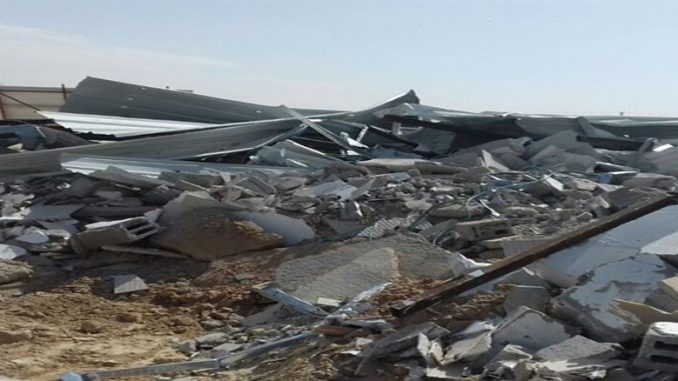Head of the regional council for unrecognized Bedouin villages Attiya al-Asam said that the Israeli demolition campaign in the Negev had “crossed all lines” by targeting the homes of disabled residents, adding that the recent wave of demolitions were “inhumane” and were motivated by “hatred for the Arabs,” reported Ma’an News Agency.
He added that Israeli police and authorities had dealt with the recent evacuation of the illegal Israeli outpost of Amona with “patience,” while the government has “done everything to solve the settlers’ problems, pay them compensation, and provide them new homes.” However, the demolitions carried out on Palestinian homes are done with “cruel methods,” while leaving “women, children, and even handicapped individuals homeless in cold weather and rain.”
Eyewitnesses said that Israeli forces and bulldozers were still present in the area, including in the area of Beersheba, since the early morning, sparking fear among residents that more demolitions might be carried out.
Israeli forces also leveled lands at the Gulim bus station in Rahat, a recognized Bedouin city in southern Israel, on Wednesday. The head of the Galim Public Transportation Company in Rahat held the mayor responsible for the activities in the area.
The Israeli government has plans to evacuate thousands of Bedouin residents to officially recognized Bedouin townships, one of which is Rahat, in order to build new housing on the evacuated land for non-Bedouin Israeli citizens.
The ongoing attempts at transferring the Bedouins originated from the Prawer Report, a document outlining expulsion plans for the unrecognized Bedouin community. It was officially adopted by the Israeli government in 2013.
According to Israeli human rights group Adalah, the plan would “result in the destruction of 35 ‘unrecognized’ Arab Bedouin villages, the forced displacement of up to 70,000 Arab Bedouin citizens of Israel, and the dispossession of their historical lands in the Negev.”
Bedouin communities in the Negev have been the target of a heightened demolition campaign in recent weeks, following Israeli leaders publicly expressing their commitment to demolish Palestinian structures lacking difficult to obtain Israeli-issued building permits across Israel and occupied East Jerusalem in response to the Israeli-court sanctioned evacuation of the illegal Amona settler outpost.
In December, Netanyahu released a video to address settlers of the Amona outpost, assuring them that he would commit to “enforcing laws” on “illegal construction” in Israel, referring primarily to Palestinian communities that are often forced to build without Israeli-issued building permits, due to what rights groups have attributed to discriminatory zoning policies in Israel which have excluded many Palestinian-Israeli communities from being included in the regional and municipal development plans.
According to the Association for Civil Rights in Israel (ACRI), more than half of the approximately 160,000 Negev Bedouins reside in unrecognized villages.
While Bedouins of the Negev are Israeli citizens, rights groups have claimed that the demolition of unrecognized Bedouin villages is a central Israeli policy aimed at removing the indigenous Palestinian population from the Negev and transferring them to government-zoned townships to make room for the expansion of Jewish Israeli communities.
The classification of their villages as “unrecognized” prevents Bedouins from developing or expanding their communities, as their villages are considered illegal by Israeli authorities.
Israeli authorities have also refused to connect unrecognized Bedouin villages to the national water and electricity grids, while excluding the communities from access to health and educational services, and basic infrastructure.
Many of the Bedouins were forcibly transferred to the village sites during the 17-year period when Palestinians inside Israel were governed under Israeli military law, which ended shortly before Israel’s military takeover of Gaza and the West Bank, including East Jerusalem, in 1967.
Now more than 60 years later, the villages have yet to be recognized by Israel and live under constant threats of demolition and forcible removal.


